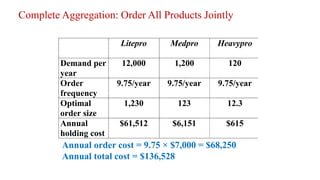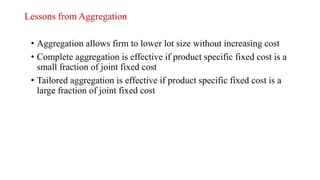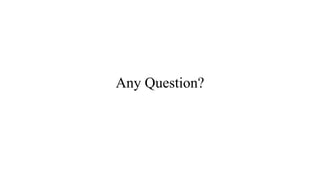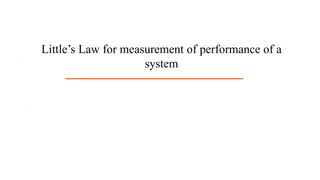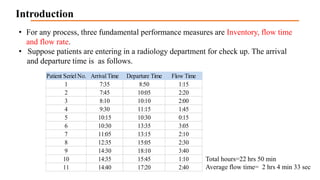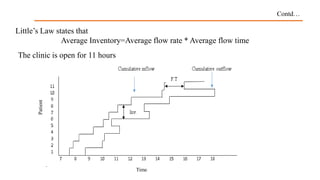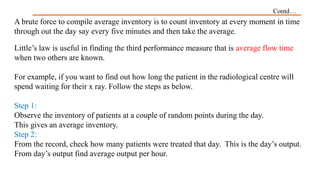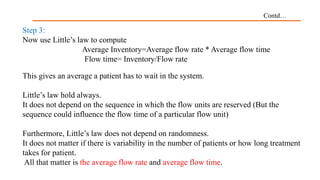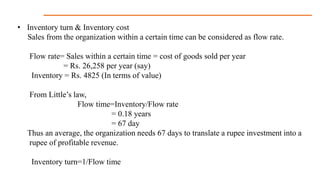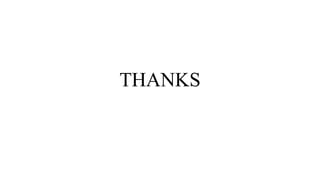Managing Inventory In SC Lect#12 in.pptx
- 1. Managing Inventory In SC Lect delivered by S P Sarmah
- 2. Introduction Inventory is a material held in an idle or incomplete state awaiting future Sale or use. Inventories are common to all organizations including: ’éĘ Farms ’éĘ Manufactures ’éĘ Retailers ’éĘ Hospitals ’éĘ Universities ’éĘ Families, etc
- 3. 3 Inventory at different stages in Supply Chain From supplier through manufacturing and distribution chain to the end user Suppliers Customers Raw- material Inven- tory Finished Factory Inven- tory Distribution Inventory Selling from Inven- tory In-process Inventory Procu- rement Orders Shop Orders MPS Orders Factory Orders Distri- bution Orders Customer Orders Supply chain
- 4. ŌĆó Inventory may have significant impact on -Customer Service level & -Supply Chain system wide cost
- 5. TYPES OF INVENTORY MAINTAINED BY A MANUFACTURING ORGANIZATION ŌĆó Supplies: Inventory items consumed in the normal functioning that are not part of the final product. ŌĆó Raw Materials: Items purchased from suppliers to be used as inputs into the production process. ŌĆó In-Process Goods: Partially completed final products that are still in the production process. ŌĆó Finished Goods: Final product, available for sale, distribution, or storage.
- 6. ŌĆó Why hold inventory at all? - Due to mismatch between demand and supply. - Unexpected changes in customer demand. Uncertainty in customer demand has increased due to short life cycle of product. - Historical data about customer may not be available - Economies of scale offered by transportation also encourage firms to transport large quantities of items & therefore, hold large inventories - A significant uncertainty in quality of the supply, uncertainty with supplier cost and delivery lead time
- 7. INVENTORY COSTS ŌĆó Purchase Cost (P): It is the unit purchase price if it is obtained from an external source, or the unit production cost if it is produced internally. ŌĆó Order/Setup Cost (C): Expense incurred in issuing a purchase order to an outside supplier or from internal production setup costs. ŌĆó Holding Cost (H): The cost associated with investing in inventory and maintaining the physical investment in storage. It incorporates such items as cost of capital, taxes, insurance, handling, storage, shrinkage, obsolescence, and deterioration. On an annual basis, they most commonly range from 20% to 40% of the investment. ŌĆó Stockout Costs: It is the economic consequence of an external or internal shortage. External shortage can incur backorder costs, present profit loss and future profit loss. Internal shortages can result in lost production and a delay in a completion date.
- 8. Economies of Scale to Exploit Fixed Costs ŌĆó Lot sizing for a single product (EOQ) ŌĆó Aggregating multiple products in a single order ŌĆó Lot sizing with multiple products or customers ŌĆó Lots are ordered and delivered independently for each product ŌĆó Lots are ordered and delivered jointly for all products ŌĆó Lots are ordered and delivered jointly for a subset of products
- 9. Fig. Classical Inventory Model ; / 2 ; int int ; Q lot size Q averageinventory B reorder po ac ce erval betweenorders ab cd elead time ’ĆĮ ’ĆĮ ’ĆĮ ’ĆĮ ’ĆĮ ’ĆĮ ’ĆĮ Lot sizing for a single product: Economic Order Quantity Model (EOQ)
- 10. Role of Cycle Inventory in a Supply Chain ŌĆó Lot, or batch size: quantity that a supply chain stage either produces or orders at a given time ŌĆó Cycle inventory: Average inventory that builds up in the supply chain because a SC stage either produces or purchases in lots that are larger than those demanded by the customer ŌĆó Q = lot or batch size of an order ŌĆó d = demand per unit time ŌĆó Inventory profile: Plot of the inventory level over time as shown in the fig. ŌĆó Cycle inventory = Q/2 (depends directly on lot size) ŌĆó Average flow time = Avg inventory / Avg flow rate ŌĆó Average flow time from cycle inventory = Q/(2d)
- 11. Role of Cycle Inventory in a Supply Chain Suppose Lot Size Q = 1000 units Demand d = 100 units/day Cycle inventory = Q/2 = 1000/2 = 500 = Avg inventory level from cycle inventory Avg flow time = Q/2d = 1000/(2)(100) = 5 days ŌĆó Cycle inventory adds 5 days to the time a unit spends in the supply chain ŌĆó Lower cycle inventory is better because: ŌĆó Average flow time is lower ŌĆó Working capital requirements are lower ŌĆó Lower inventory holding costs
- 12. Role of Cycle Inventory in a Supply Chain ŌĆó Cycle inventory is held primarily to take advantage of economies of scale in the SC ŌĆó SC costs influenced by lot size: ŌĆó Purchase cost = P ŌĆó Fixed ordering cost = A ŌĆó Holding cost = H = PF (where F is the HC fraction expressed as percentage of Unit Purchase cost) ŌĆó Primary role of cycle inventory is to allow different stages to purchase product in lot sizes that minimize the sum of Purchase, Ordering, and Holding costs ŌĆó Ideally, cycle inventory decisions should consider costs across the entire supply chain, but in practice often, each stage generally makes its own supply chain decisions ŌĆō increases total cycle inventory and total costs in the supply chain
- 13. Economies of Scale to Exploit Fixed Costs: Lot sizing for a single product (EOQ) D = Annual demand (Unit per year) A = Ordering cost (Rs per order) Independent of order size (Fixed Cost) H = Inv. Carrying cost (Rs.per unit per year): Dependent on Order Size P = Unit Purchase price (Rs per unit) F = Fractional holding cost of unit purchase price H = PF Q = Lot size (Decision Variable) Total cost = Purchase cost + Ordering cost + Holding cost H 2 Q A Q D DP ) ( TC ’Ć½ ’Ć½ ’ĆĮ Q ’Ć© ’Ć® Cost holding Inventory demand al Cost xAnnu 2 Q 2 2 , 0 * * Ordering PF AD H AD Q weget dQ TC d ’é┤ ’ĆĮ ’ĆĮ ’ĆĮ ’ĆĮ Note : As unit price of the item increases, lot size decreases. It means order frequently in smaller lot size. This is applicable for high valued items.
- 14. Optimum Order Lot Size: Trade off Between OC &HC Q* Total relevant costs Quantity ordered, Q Total costs Ordering Cost= AD/Q Holding costs= QH/2 0 0
- 15. 12 DL B ’ĆĮ * Q D D Q* H Q Q AD DP 2 * * ’Ć½ ’Ć½ ’ĆĮ Reorder point , when lead time is in month (as both units should be same) No. of orders = Total Min. cost Order interval time T = ADPF ADH TC 2 2 * ’ĆĮ ’ĆĮ
- 16. Example: Demand, D = 12,000 computers per year d = 1000 computers/month Unit cost, P = $500 Holding cost fraction, F = 0.2 Fixed cost, A = $4,000/order Q* = Sqrt[(2)(12000)(4000)/(0.2)(500)] = 980 computers Cycle inventory = Q/2 = 490 Flow time = Q/2d = 980/(2)(1000) = 0.49 month Reorder interval, =Q/d= T = 0.98 month
- 17. Example (continued) Annual ordering and holding cost =TC= = (12000/980)(4000) + (980/2)(0.2)(500) = $97,980 Suppose lot size is reduced to Q=200, which would reduce flow time: Annual ordering and holding cost = = (12000/200)(4000) + (200/2)(0.2)(500) = $250,000 To make it economically feasible to reduce lot size, the fixed cost associated with each lot would have to be reduced
- 18. Example If desired lot size = Q* = 200 units, what would ŌĆśAŌĆÖ have to be? D = 12000 units P = $500 F = 0.2 Use EOQ equation and solve for S: A = [PF(Q*)2]/2D = [(0.2)(500)(200)2]/(2)(12000) = $166.67 To reduce optimal lot size by a factor of k, the fixed order cost must be reduced by a factor of k2
- 19. Key Points from EOQ Model ŌĆó In deciding the optimal lot size, the tradeoff is between setup (order) cost and holding cost. ŌĆó If demand increases by a factor of 4, it is optimal to increase batch size by a factor of 2 and produce (order) twice as often. Cycle inventory (in days of demand) should decrease as demand increases. ŌĆó If lot size is to be reduced, one has to reduce fixed order cost. To reduce lot size by a factor of 2, order cost has to be reduced by a factor of 4.
- 20. Economic Production Quantity Model (EPQ) ŌĆó D- Annual demand ŌĆó p ŌĆō production rate ŌĆó m ŌĆō demand rate ŌĆó P- unit variable cost ŌĆó H- Inventory holding cost Objective ŌĆō What is the optimum production quantity to minimize the total cost in the system?
- 21. p Q t p t Q p p ’ĆĮ ’é┤ ’ĆĮ Production run quantity = Time between production run = tp ) ( 1 m p t Q p ’ĆŁ ’ĆĮ Max inventory = ’Ć© ’Ć® ’Ć© ’Ć® ’āĘ ’āĘ ’āĖ ’āČ ’ā¦ ’ā¦ ’ā© ’ā” ’ĆŁ ’ĆĮ ’ĆŁ ’ĆĮ ’ĆŁ ’ĆĮ ’ĆĮ p m Q m p P Q m p t Q p 1 2 1 2 1 2 1 2 1 Average inventory
- 22. ’Ć© ’Ć®H m p p Q Q AD DP ’ĆŁ ’Ć½ ’Ć½ 2 1 Total annual cost (TAC) = ’Ć© ’Ć® ’āĘ ’āĘ ’āĖ ’āČ ’ā¦ ’ā¦ ’ā© ’ā” ’ĆŁ ’ĆĮ ’ĆĮ p m H AD Q dQ TAC d 1 2 * 0 ’éź ’é« p H AD Q 2 ’ĆĮ Note ŌĆō When production rate is infinite i.e (same as or EOQ model)
- 23. ’Ć© ’Ć® ’āĘ ’āĘ ’āĖ ’āČ ’ā¦ ’ā¦ ’ā© ’ā” ’ĆŁ ’Ć½ ’ĆĮ ’āĘ ’āĘ ’āĖ ’āČ ’ā¦ ’ā¦ ’ā© ’ā” ’ĆŁ ’Ć½ ’Ć½ ’ĆĮ p m ADH DP TC H p m Q Q AD DP TC Q Q 1 2 1 2 * * ) ( * * Total minimum cost Exercise: An item may be purchased for Rs 25 per unit or manufactured at a rate of 10,000 units per year for Rs. 23. if purchased, the order cost will be Rs. 5 compared to a Rs. 50 set up cost for manufacturing Annual demand D = 2500 units per year; Holding cost fraction F = 10% Should the item be purchased externally or produced internally ?
- 24. When the item is purchased from outside 100 * 25 1 . 0 2500 5 2 2 * ’ĆĮ ’é┤ ’é┤ ’é┤ ’ĆĮ ’ĆĮ ’ĆĮ Q PF AD Q EOQ ’Ć© ’Ć® ’Ć© ’Ć® . 62750 1 . 0 25 2500 5 2 25 2500 2 * * Rs TAC ADPF DP TAC Q Q ’ĆĮ ’é┤ ’é┤ ’é┤ ’é┤ ’Ć½ ’é┤ ’ĆĮ ’Ć½ ’ĆĮ When the item is produced internally 380 * 10000 2500 1 1 . 0 23 2500 50 2 1 2 * ’ĆĮ ’āĘ ’āĖ ’āČ ’ā¦ ’ā© ’ā” ’ĆŁ ’é┤ ’é┤ ’é┤ ’é┤ ’ĆĮ ’āĘ ’āĘ ’āĖ ’āČ ’ā¦ ’ā¦ ’ā© ’ā” ’ĆŁ ’ĆĮ ’ā× Q p m PF AD Q EPQ ’Ć© ’Ć® . 7 . 58156 1 2 * Rs p m ADPF DP TAC Q ’ĆĮ ’āĘ ’āĘ ’āĖ ’āČ ’ā¦ ’ā¦ ’ā© ’ā” ’ĆŁ ’Ć½ ’ĆĮ ’Ć© ’Ć® ’Ć© ’Ć®Purchase oduction TAC TAC ’Ć╝ Pr
- 25. Any Question?
- 26. Aggregating Multiple Products in a Single Order ŌĆó Transportation is a significant contributor to the fixed cost per order ŌĆó One can possibly combine shipments of different products from the same supplier ŌĆó same overall fixed cost ŌĆó shared over more than one product ŌĆó effective fixed cost is reduced for each product ŌĆó lot size for each product can be reduced ŌĆó One can also have a single delivery coming from multiple suppliers or a single truck delivering to multiple retailers ŌĆó Aggregating across products, retailers, or suppliers in a single order allows for a reduction in lot size for individual products because fixed ordering and transportation costs are now spread across multiple products, retailers, or suppliers
- 27. Example: Multiple products Company is dealing four types of computer model and demand of each one is given below Demand, Di = 12,000 of each type of computers per year di = 1000 computers/month Unit cost, P = $500 Holding cost fraction, F = 0.2 Fixed cost, A = $4,000/order Q* = Sqrt[(2)(12000)(4000)/(0.2)(500)] = 980 computers
- 28. Example: Aggregating Multiple Products in a Single Order ŌĆó If each product is ordered separately: ŌĆó Q* = 980 units for each product ŌĆó Total cycle inventory = 4(Q/2) = (4)(980)/2 = 1960 units ŌĆó Aggregate orders of all four products: ŌĆó Combined Q* = 1960 units ŌĆó For each product: Q* = 1960/4 = 490 ŌĆó Cycle inventory for each product is reduced to 490/2 = 245 ŌĆó Total cycle inventory = 1960/2 = 980 units ŌĆó Average flow time, inventory holding costs will be reduced
- 29. Lot Sizing with Multiple Products or Customers ŌĆó In practice, the fixed ordering cost is dependent at least in part on the variety associated with an order of multiple models ŌĆó A portion of the cost is related to transportation (independent of variety) ŌĆó A portion of the cost is related to loading and receiving (not independent of variety) ŌĆó Three scenarios: ŌĆó Lots are ordered and delivered independently for each product ŌĆó Lots are ordered and delivered jointly for all three models ŌĆó Lots are ordered and delivered jointly for a selected subset of models
- 30. 10-30 Lot Sizing with Multiple Products ŌĆó Demand per year ŌĆó DL = 12,000; DM = 1,200; DH = 120 ŌĆó Common transportation cost, A = $4,000 ŌĆó Product specific order cost ŌĆó AL = $1,000; AM = $1,000; AH = $1,000 ŌĆó Holding cost fraction, F= h = 0.2 ŌĆó Holding cost H = FP=hP ŌĆó Unit purchase cost ŌĆó PL = $500; PM = $500; PH = $500
- 31. Delivery Options ŌĆó No Aggregation: Each product ordered separately ŌĆó Complete Aggregation: All products delivered on each truck ŌĆó Tailored Aggregation: Selected subsets of products on each truck
- 32. No Aggregation: Order Each Product Independently Litepro Medpro Heavypro Demand per year 12,000 1,200 120 Fixed cost / order $5,000 $5,000 $5,000 Optimal order size 1,095 346 110 Order frequency 11.0 / year 3.5 / year 1.1 / year Annual cost $109,544 $34,642 $10,954 Total cost = $155,140
- 33. Aggregation: Order All Products Jointly All three models are included each time an order is placed The combined fixed order cost per order is given by A* = A + AL + AM + AH = 4000+1000+1000+1000 = $7000 Suppose n be the number of orders placed per year. Total annual Ordering Cost = n A* Total annual HC = DLFPL/2n + DMFPM/2n + DHFPH/2n TC = Ordering Cost + Holding Cost n* = Sqrt[(DLFPL+ DMFPM+ DHFPH)/2A*] = 9.75 QL = DL/n* = 12000/9.75 = 1230 QM = DM/n* = 1200/9.75 = 123 QH = DH/n* = 120/9.75 = 12.3 Cycle inventory = Q/2 Average flow time = (Q/2)/(weekly demand)
- 34. Complete Aggregation: Order All Products Jointly Litepro Medpro Heavypro Demand per year 12,000 1,200 120 Order frequency 9.75/year 9.75/year 9.75/year Optimal order size 1,230 123 12.3 Annual holding cost $61,512 $6,151 $615 Annual order cost = 9.75 ├Ś $7,000 = $68,250 Annual total cost = $136,528
- 35. Lessons from Aggregation ŌĆó Aggregation allows firm to lower lot size without increasing cost ŌĆó Complete aggregation is effective if product specific fixed cost is a small fraction of joint fixed cost ŌĆó Tailored aggregation is effective if product specific fixed cost is a large fraction of joint fixed cost
- 36. Any Question?
- 37. Title Scholar Supervisor LittleŌĆÖs Law for measurement of performance of a system
- 38. Introduction ŌĆó For any process, three fundamental performance measures are Inventory, flow time and flow rate. ŌĆó Suppose patients are entering in a radiology department for check up. The arrival and departure time is as follows. Patient SerielNo. ArrivalTime Departure Time Flow Time 1 7:35 8:50 1:15 2 7:45 10:05 2:20 3 8:10 10:10 2:00 4 9:30 11:15 1:45 5 10:15 10:30 0:15 6 10:30 13:35 3:05 7 11:05 13:15 2:10 8 12:35 15:05 2:30 9 14:30 18:10 3:40 10 14:35 15:45 1:10 11 14:40 17:20 2:40 Total hours=22 hrs 50 min Average flow time= 2 hrs 4 min 33 sec
- 39. LittleŌĆÖs Law states that Average Inventory=Average flow rate * Average flow time ContdŌĆ” The clinic is open for 11 hours Time Patient
- 40. ContdŌĆ” A brute force to compile average inventory is to count inventory at every moment in time through out the day say every five minutes and then take the average. LittleŌĆÖs law is useful in finding the third performance measure that is average flow time when two others are known. For example, if you want to find out how long the patient in the radiological centre will spend waiting for their x ray. Follow the steps as below. Step 1: Observe the inventory of patients at a couple of random points during the day. This gives an average inventory. Step 2: From the record, check how many patients were treated that day. This is the dayŌĆÖs output. From dayŌĆÖs output find average output per hour.
- 41. ContdŌĆ” Step 3: Now use LittleŌĆÖs law to compute Average Inventory=Average flow rate * Average flow time Flow time= Inventory/Flow rate This gives an average a patient has to wait in the system. LittleŌĆÖs law hold always. It does not depend on the sequence in which the flow units are reserved (But the sequence could influence the flow time of a particular flow unit) Furthermore, LittleŌĆÖs law does not depend on randomness. It does not matter if there is variability in the number of patients or how long treatment takes for patient. All that matter is the average flow rate and average flow time.
- 42. ŌĆó Inventory turn & Inventory cost Sales from the organization within a certain time can be considered as flow rate. Flow rate= Sales within a certain time = cost of goods sold per year = Rs. 26,258 per year (say) Inventory = Rs. 4825 (In terms of value) From LittleŌĆÖs law, Flow time=Inventory/Flow rate = 0.18 years = 67 day Thus an average, the organization needs 67 days to translate a rupee investment into a rupee of profitable revenue. Inventory turn=1/Flow time
- 43. THANKS
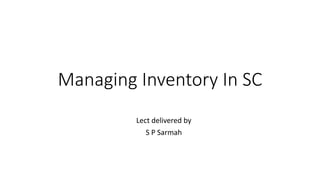
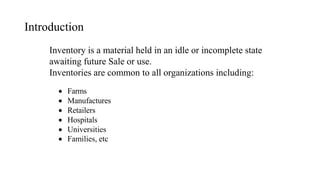
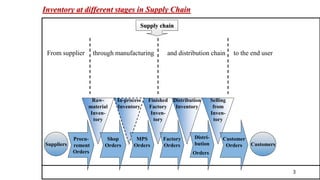

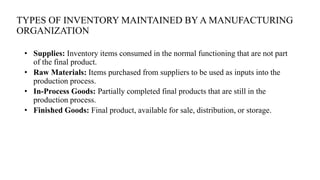
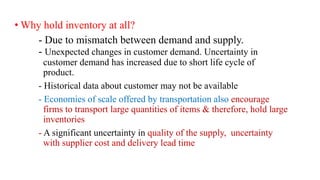
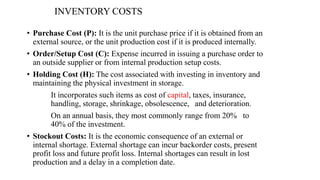
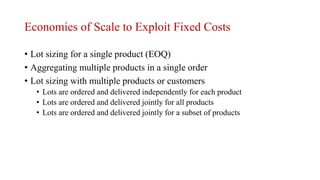
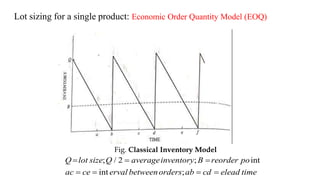
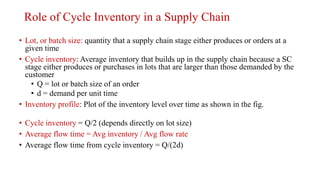
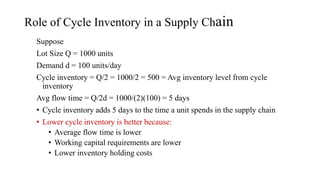
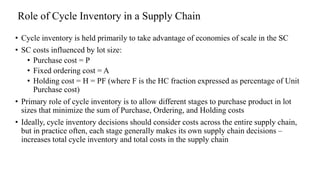
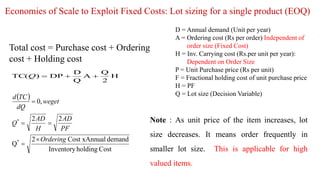
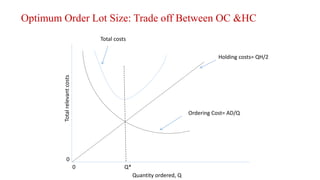
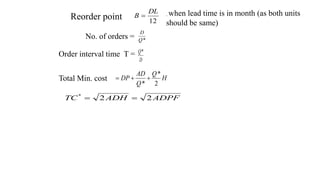
![Example:
Demand, D = 12,000 computers per year
d = 1000 computers/month
Unit cost, P = $500
Holding cost fraction, F = 0.2
Fixed cost, A = $4,000/order
Q* = Sqrt[(2)(12000)(4000)/(0.2)(500)] = 980 computers
Cycle inventory = Q/2 = 490
Flow time = Q/2d = 980/(2)(1000) = 0.49 month
Reorder interval, =Q/d= T = 0.98 month](https://image.slidesharecdn.com/managinginventoryinsclect12-240409202920-d572b761/85/Managing-Inventory-In-SC-Lect-12-in-pptx-16-320.jpg)
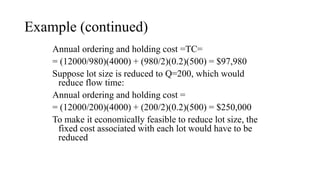
![Example
If desired lot size = Q* = 200 units, what would ŌĆśAŌĆÖ have
to be?
D = 12000 units
P = $500
F = 0.2
Use EOQ equation and solve for S:
A = [PF(Q*)2]/2D = [(0.2)(500)(200)2]/(2)(12000)
= $166.67
To reduce optimal lot size by a factor of k, the fixed order cost
must be reduced by a factor of k2](https://image.slidesharecdn.com/managinginventoryinsclect12-240409202920-d572b761/85/Managing-Inventory-In-SC-Lect-12-in-pptx-18-320.jpg)
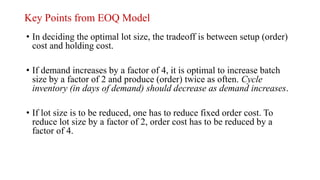
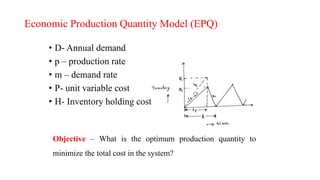
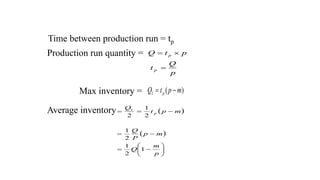
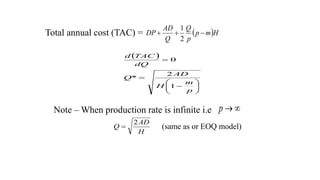
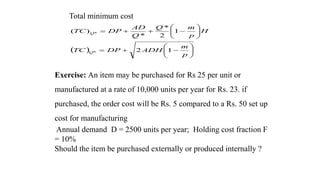
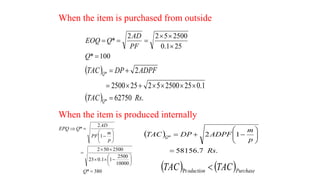
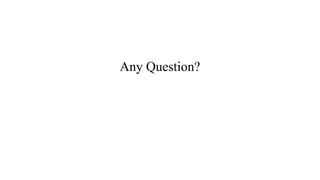
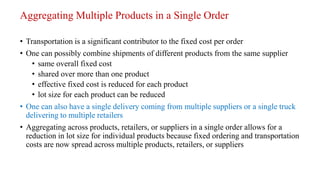
![Example: Multiple products
Company is dealing four types of computer model and demand of each
one is given below
Demand, Di = 12,000 of each type of computers per year
di = 1000 computers/month
Unit cost, P = $500
Holding cost fraction, F = 0.2
Fixed cost, A = $4,000/order
Q* = Sqrt[(2)(12000)(4000)/(0.2)(500)] = 980 computers](https://image.slidesharecdn.com/managinginventoryinsclect12-240409202920-d572b761/85/Managing-Inventory-In-SC-Lect-12-in-pptx-27-320.jpg)
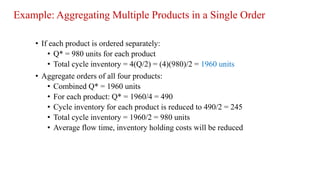

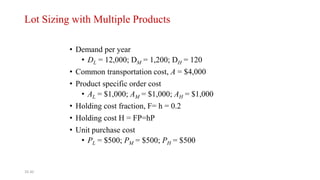
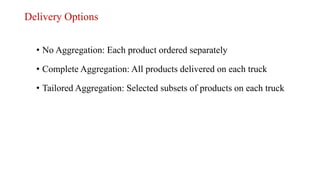
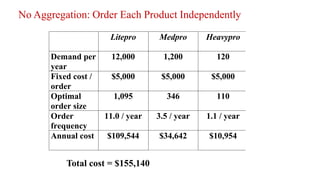
![Aggregation: Order All Products Jointly
All three models are included each time an order is placed
The combined fixed order cost per order is given by
A* = A + AL + AM + AH = 4000+1000+1000+1000 = $7000
Suppose n be the number of orders placed per year.
Total annual Ordering Cost = n A*
Total annual HC = DLFPL/2n + DMFPM/2n + DHFPH/2n
TC = Ordering Cost + Holding Cost
n* = Sqrt[(DLFPL+ DMFPM+ DHFPH)/2A*]
= 9.75
QL = DL/n* = 12000/9.75 = 1230
QM = DM/n* = 1200/9.75 = 123
QH = DH/n* = 120/9.75 = 12.3
Cycle inventory = Q/2
Average flow time = (Q/2)/(weekly demand)](https://image.slidesharecdn.com/managinginventoryinsclect12-240409202920-d572b761/85/Managing-Inventory-In-SC-Lect-12-in-pptx-33-320.jpg)
